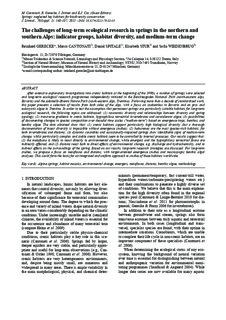| dc.description.abstract | After extensive exploratory investigations into crenic habitats at the beginning of the 1990s, a number of springs were selected and long-term ecological research programmes independently initiated in the Berchtesgaden National Park (north-eastern Alps, Bavaria) and the Adamello-Brenta Nature Park (south-eastern Alps, Trentino). Following more than a decade of standardized work, this paper presents a selection of results from both sides of the Alps, with a focus on zoobenthos in Bavaria and on pro- and eukaryotic algae in Trentino. In order to test the assumption that permanent springs are particularly suitable habitats for long-term ecological research, the following topics are addressed: (1) taxonomic diversity and relationships between diversity and spring typology; (2) transverse gradients in crenic habitats, hygrophilous terrestrial invertebrates and xerotolerant algae; (3) possibilities of documenting changes in species composition over decadal time scales ("medium-term") based on emergence traps, benthos, and benthic algae. The data obtained show that: (1) crenic habitats support particularly high biological diversity (but a thorough documentation of insect diversity is impossible without emergence studies); (2) helocrenes are the most species-rich habitats, for both invertebrates and diatoms; (3) dynamic (unstable) and occasionally-impacted springs show identifiable signs of medium-term change, whilst particularly complex and stable crenic habitats seem to be controlled by internal processes. Our results suggest that: (1) the meiofauna is likely to react directly to environmental change, while emergers and the hygrophilous terrestrial fauna are indirectly affected, and (2) diatoms react both to direct effects of environmental change, e.g. discharge and hydrochemistry, and to indirect effects on the surroundings of the spring. Based on our results, long-term research strategies are discussed. For long-term studies, we propose a focus on meiofauna and diatoms, with target-oriented emergence studies and macroscopic benthic algal analyses. This could form the basis for an integrated and uniform approach to studies of these habitats worldwide. | nb_NO |

